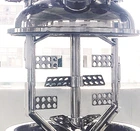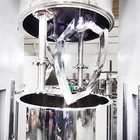Cosmetic Manufacturing: Best Lab Equipment for Small Batch Production
Small batch cosmetic production is a practical and flexible way to develop skincare, body care, and beauty products without committing to large-scale infrastructure. Whether you’re a formulator working from a lab or a brand running pilot production, using the right tools ensures consistency, safety, and quality from the first batch.
But it’s not just about convenience — in cosmetics, equipment directly affects product texture, stability, and safety. A mistake during blending or packaging can compromise not only the formula but also consumer health and brand integrity.
This guide outlines the essential lab equipment for small batch manufacturing, the risks of contamination, and the benefits of testing and scaling smart.
What Counts as Small Batch Production?
Small batch typically means:
- Producing under 100 units per formula
- Focusing on custom, artisanal, or test batches
- Selling online, locally, or through niche retail
- Being able to test and adapt quickly before scaling up
It’s the preferred model for early-stage brands and R&D labs developing new products, especially where flexibility and experimentation are key. Unfortunately, this is one of the places where contamination is more likely to happen, leading to serious risks for both the consumer and your business.
Contamination: Real Risks for Small Producers
Contamination is a serious issue in cosmetics. Bacteria, mold, and unstable ingredients can enter a product at any stage: from poor sanitization to incorrect filling techniques.
Why it matters:
For the consumer:
- Skin irritation or allergic reactions
- Infections, especially in eye or open-skin products
- Accelerated product spoilage
- Loss of trust in your brand — even from a single adverse reaction
For your business:
- Product recalls or complaints
- Negative reviews or public backlash - Legal liability — especially if no safety or pH testing was done
- Rejected by retailers or certifiers
- Inability to meet GMP expectations
- Suspended operations if found non-compliant (FDA, EU, etc.)
- Harmed reputation, which can be hard to recover from
Small batch labs often work more directly with raw materials which increases the risk of contamination if hygiene and process control are not in place. Even small brands are accountable for product safety under Good Manufacturing Practices (GMP) and local cosmetic laws. That’s why every piece of equipment — even a funnel or spoon — must be cleaned and sanitized before use.
Small batch production is easier to control, so take advantage of that by setting high standards from day one.
Best Equipment for Small Batch Cosmetic Manufacturing
Here’s what you need to produce small batches of creams, lotions, balms, and more — cleanly and consistently. Each tool below is suitable for labs or small workshops making under 100 units per formula.
Mixing & Blending
Purpose: Combine oils, water, and actives evenly — especially for emulsions like creams and lotions.
|
Tool |
When to Use |
Why It Works |
|
Overhead Mixer |
For thick creams and butters |
Handles dense textures without introducing too much air |
|
For smooth, stable emulsions |
Breaks down particles for better texture and shelf life |
|
|
Stick Blender |
Small test batches (<1L) |
Affordable and easy to clean — good for early trials |
|
Magnetic Stirrer + Hot Plate |
Serums, gels, or heating water phase |
Keeps liquids moving gently while heating evenly |
Tips:
- Pre-mix powders or gums in glycerin to avoid clumping.
- Use a tall beaker to reduce splashing during blending.
- Always sanitize blades between uses to avoid contamination.
Risks:
- Under-mixing can result in unstable emulsions.
- Overheating during blending can degrade sensitive actives.
- Using the wrong tool (e.g., stick blender for thick creams) leads to poor texture.
Heating & Melting Tools
Purpose: Melt butter, waxes, or heat water and oil phases before mixing.
|
Tool |
When to Use |
Why It Works |
|
Double Boiler / Water Bath |
Oils, butters, melt-and-pour soap |
Gentle heat without burning ingredients |
|
Hot Plate + Beaker |
Controlled melting or separate phases |
Good temperature accuracy for emulsions |
|
Wax Melter (with stirrer) |
Larger balm or butter batches |
Holds more volume and keeps it melted while working |
Tips:
- Always monitor temperature with a thermometer.
- Melt waxes and butters separately from actives to avoid degradation.
- Clean residue off hot plates after each use.
Risks:
- Overheating can break down emulsifiers or damage oils.
- Direct heat (without water bath) may scorch ingredients.
- Inconsistent temperature leads to poor emulsification.
Measuring & Weighing Tools
Purpose: Get precise quantities — essential for preservatives, actives, and pH control.
|
Tool |
Use |
Notes |
|
Digital Scale (0.01g) |
All ingredients |
A must-have for accurate, repeatable batches |
|
Beakers & Cylinders |
Measuring liquids |
Use borosilicate glass for hot materials |
|
Spoons & Micro Scoops |
Powders, colorants |
Still weigh them — volume is not reliable |
Tips:
- Calibrate your scale regularly.
- Tare your container before adding ingredients.
- Measure liquids by weight, not volume, when possible.
Risks:
- Inaccurate weights can compromise product safety.
- Contaminated scoops or glassware may introduce bacteria.
- Using too small a scale range may lead to misreadings.
Filling Equipment
Purpose: Get your product into containers cleanly and evenly.
|
Tool |
Best For |
Notes |
|
Manual Piston Filler |
Creams, lotions, gels |
More consistent than hand pouring; faster for 50–200 containers |
|
Syringes / Pipettes |
Small vials, serums |
Accurate for samples or precise fills |
|
Funnels (with strainer) |
Oils, cleansers |
Helps avoid spills and keeps solids out of packaging |
Tips:
- Sanitize contact surfaces before each use.
- Test filling speed and volume with water first.
- Use dedicated tools for oil- vs. water-based products.
Risks:
- Cross-contamination between batches if not cleaned.
- Manual filling can introduce air bubbles.
- Incorrect fills can lead to leakage or spoilage.
Packaging & Sealing Tools
Purpose: Protect your product during storage and shipping.
|
Tool |
Use |
Notes |
|
Heat Sealer |
Sealing bags or foil sachets |
Keeps air and moisture out |
|
Shrink Wrap Gun/Tunnel |
Wraps bottles, jars |
Adds tamper protection and a clean finish |
Tips:
- Always seal in a clean, dry environment.
- Label before shrink wrapping to avoid distortion.
- Test on a few units before full batch sealing.
Risks:
- Poor seals allow contamination or leakage.
- Overheating can warp packaging.
- Inconsistent sealing weakens shelf life.
Sanitation & Safety Equipment
Purpose: Keep your space and tools clean. Even small mistakes here can lead to mold or product failure.
|
Tool |
Use |
Notes |
|
Gloves, Hair Net, Lab Coat |
Personal hygiene |
Keeps you out of the product — literally |
|
Alcohol Spray (70%) |
Cleaning tools and surfaces |
Wipe everything before and after use |
|
UV Sterilizer or Autoclave |
Optional, for reusing tools |
Helps kill bacteria in beakers, spatulas |
Tips:
- Sanitize before and after every batch.
- Use disposable pipettes and gloves where possible.
- Store clean tools in sealed containers.
Risks:
- Poor hygiene leads to mold, separation, or rancidity.
- Reusing unclean tools spreads microbes.
- Cross-contamination between formulas affects stability.
Testing & Control Tools
Purpose: Catch pH or stability problems before distribution.
|
Tool |
Use |
Why It Matters |
|
pH Meter or Strips |
Check before filling |
pH that’s too high or low can irritate skin |
|
Viscometer |
Optional — measure texture |
Helps track consistency across batches |
|
Stability Box / DIY Test |
Check over time |
Simulate temperature changes to test shelf life |
Tips:
- Always test pH after cooling.
- Keep a sample from each batch for long-term monitoring.
- Label and date every test clearly.
Risks:
- Skipping testing leads to instability or irritation.
- Misinterpreting pH causes formula failure.
- Inconsistent records make troubleshooting hard.
Starter Kit: Equipment for Beginners
For those just getting started, here’s a compact, low-cost setup that covers the essentials:
|
Equipment |
Use |
|
Digital scale (0.01g) |
Weighing ingredients / Prevents errors |
|
Stick blender |
Emulsifying small batches |
|
Magnetic stirrer + hot plate |
Controlled heating and mixing |
|
Beakers (250 ml & 500 ml) |
Mixing and transfers |
|
Funnels, pipettes, syringes |
Precise filling |
|
Alcohol spray |
Tool and surface sanitation |
|
pH test strips |
Basic product testing |
Final Notes: Start Small, Stay Smart
Small batch production offers flexibility, creativity, and control. But it also requires careful process management — especially when it comes to sanitation and equipment choice.
Tips for success:
- Keep detailed records (ingredients, time, temp)
- Always clean before and after production
- Perform small stability or pH tests before distribution
- Invest slowly in reliable equipment as you grow
In cosmetics, safety is just as important as creativity. By choosing the right tools and maintaining clean processes, you create products that are not only beautiful — but also stable, compliant, and trusted.
Questions About Equipment or Process? We’re here to help. If you have any questions about lab setup, tools for your batch size, or upgrading from manual methods — feel free to contact us. We’ll be happy to offer advice based on your production needs and budget.














































































































